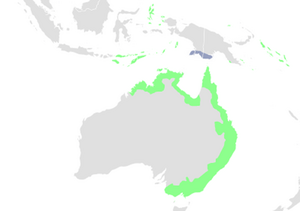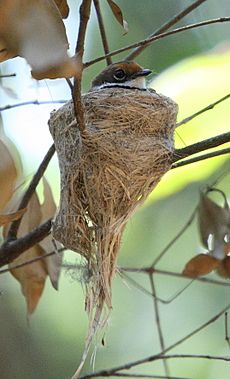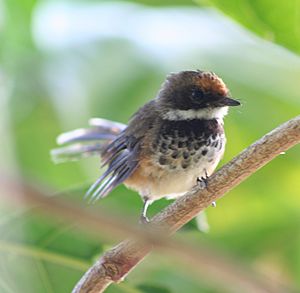Rufous fantail facts for kids
Quick facts for kids Rufous fantail |
|
|---|---|
 |
|
| Adult | |
| Conservation status | |
| Scientific classification | |
| Genus: |
Rhipidura
|
| Species: |
rufifrons
|
 |
|
| = Extant (resident) = Extant (non breeding) | |
The rufous fantail (Rhipidura rufifrons) is a small bird known for its fan-shaped tail. It's also called the black-breasted rufous-fantail or rufous-fronted fantail. You can find these birds in Australia, Indonesia, Micronesia, New Guinea, and the Solomon Islands. They live in places like rainforests, wet forests, swampy woodlands, and mangroves.
This bird is easy to spot because of its bright orange-reddish-brown back, rump, and the base of its tail. It has a black and white chest that turns white on its chin and throat.
Rufous fantails are migratory birds. This means they travel long distances. They fly to southeastern Australia in the spring to breed. Then, in the autumn, they travel north again.
These birds mostly eat small insects. They are very active, making many short flights. They also hop around in leaves or on the ground while looking for food.
Even though their numbers might be going down, the rufous fantail lives in a very large area. Because there are still many of them, the IUCN says they are a species of least concern. This means they are not currently in danger of disappearing.
Contents
Understanding Rufous Fantail Classification
The rufous fantail has a complex family tree. Scientists often debate how to group its different types, called subspecies. This is normal because classifying species is like making a hypothesis about their family history.
How the Rufous Fantail Got Its Name
The rufous fantail was first described by a scientist named Latham in 1801. He first called it Muscicapa ruffifrons. Later, other scientists moved it into the group (genus) called Rhipidura. So, its scientific name became Rhipidura ruffifrons.
The name Rhipidura comes from two Greek words: rhipido, meaning "fan-like," and oura, meaning "tail." The second part of its name, ruffifrons, comes from Latin words: rufus meaning "red" and frons meaning "forehead." So, its name basically means "red-forehead fan-tail."
Other Names for the Rufous Fantail
This bird has many other English names. Some common ones include: rufous-fronted fantail, wood fantail, red fantail, or red fan.
Family Members: Related Fantail Species
The rufous fantail is part of a large family of over 40 species called fantails, all in the genus Rhipidura. It's closely related to five other species: R. rufidorsa, R. brachyrhyncha, R. dahli, R. teysmanni, and R. dryas. Scientists believe the Arafura fantail (Rhipidura dryas) is its closest relative.
How Rufous Fantails Evolved
Scientists think the rufous fantail's ancestors first came from the Papuan region, most likely New Guinea. Over time, these birds spread out to different islands and areas. This led to many different subspecies forming, especially in the "true rufifrons" group.
Rufous Fantail Subspecies
The rufous fantail has eighteen recognized subspecies. These are different types of the same bird that have slightly different looks or live in different places. Here are some of them:
| Subspecies | Range | Notes |
|---|---|---|
| R. f. agilis | Santa Cruz Group of islands (Solomon Islands) | It has a dull brown forehead and a black throat. |
| R. f. brunnea | Malaita (Solomon Islands) | It looks like R. f. rufofronta but has darker upper parts. |
| R. f. commoda | Found in the Solomon Islands, including Bougainville Island, Guadacanal Island, Malaita Island, New Georgia group, and the Makira group. | It has a brown head and wings, bright orange-reddish-brown rump, tail-base, and forehead. Its tail is black with white tips. |
| R. f. granti | Central Solomon Islands | Similar to R. f. commoda but has black feathers over its ears. |
| R. f. intermedia | Eastern Queensland (from Cooktown to the New South Wales border) | It has more black patches near its eyes than R.f. nominate. |
| R. f. kuperi | Santa Anna (Solomon Islands) | It has more reddish-brown on its forehead and a darker neck. |
| R. f. louisiadensis | D'Entrecasteaux and Louisiade archipelagos | |
| R. f. mariae | Agiguan and Rota (Mariana Islands) | |
| R. f. melaenolaema | Vanikoro (Santa Cruz Islands) | It has less white above its eye and olive-grey upper parts. |
| R. f. rufifrons | Southeastern Australia (northeastern New South Wales to southern and central Victoria) | The tips of its tail are a light brownish-grey. |
| R. f. rufofronta | Guadalcanal (Solomon Islands) | Similar to R. f. commoda but has blackish-brown feathers over its ears. |
| R. f. russata | San Cristóbal (Solomon Islands) | It has a bright orange back instead of brown and a narrow black band on its chest. |
| R. f. saipanensis | Saipan and Tinian (Mariana Islands) | |
| R. f. torrida | Halmahera, Ternate, Bacan and Obi Maluk Islands | |
| R. f. ugiensis | Ugi (Solomon Islands) | It mostly or completely lacks white on its throat. Its upper parts are a lighter reddish-brown. |
| R. f. uraniae | Guam (Mariana Islands) | This subspecies is now extinct. |
| R. f. utupuae | Utupua (Solomon Islands) | It has a white forehead, a rusty-brown crown, and a black throat. |
| R. f. versicolor | Yap (Caroline Islands) |
Physical Description of the Rufous Fantail
Adult rufous fantails are medium-sized birds. They are usually about 14.5 to 18.5 centimeters long, with an average of 15 centimeters. Their wingspan is between 18 and 22.5 centimeters, averaging around 21 centimeters. They weigh about 10 grams. Male and female rufous fantails look the same, but females are generally a bit smaller.
Their forehead is a rich reddish-brown color, going across their eyes. Just below their eyes, they have a white arc. The top of their head, the back of their neck, and their upper back change from an olive to a reddish-brown color. This blends into a blackish-brown, long, fan-shaped tail. The base of this blackish-brown tail has a lighter color, often white.
They have black feathers covering their ears. Their throat is usually white, and they have a black bar across their upper chest. Below this, their lower chest is off-white with black, scale-like spots. This color then changes to off-white towards the middle of their belly. The bird's eyes, beak, and feet are all brown.
These colors stay the same throughout the year. Young rufous fantails, called juveniles, have duller colored backs than adults. Their tails and underparts are also slightly browner. However, the base of their beak and their legs are a lighter brown compared to an adult's.
Rufous Fantail Sounds
Scientists haven't studied the sounds of the rufous fantail very much. But people have heard them make different noises like chips, buzzes, and scolds. Their "chip call" is often the first thing people notice. This call is high-pitched, with two quick chip sounds. They make this sound when they are looking for food, defending their territory, or warning others about a predator. They also sing after sunset, sometimes to attract a mate.
Birds Similar to the Rufous Fantail
The rufous fantail is similar in size and shape to the grey fantail (Rhipidura albiscapa). However, the rufous fantail has a slightly larger fan-shaped tail. Its songs are also higher pitched and softer.
You can easily tell the rufous fantail apart by its orange-reddish-brown back, rump, and the base of its tail. It also tends to look for food in shady, moist areas close to the ground. This helps distinguish it from other fantails.
Where Rufous Fantails Live and Their Homes
Rufous Fantail Distribution
The rufous fantail lives in parts of Australia, Southeast Asia, and islands in Micronesia and Melanesia. They live all year round in the Lesser Sunda Islands and the Maluku Islands of Indonesia. You can also find them in southern New Guinea and its nearby islands, the Solomon Islands, the Marianas, and the Carolinian island of Yap. In Australia, they live along the northern and eastern coasts.
Some subspecies of the rufous fantail only live in certain areas.
Rufous Fantail Habitat
Rufous fantails live in moist and somewhat dense places. They can live in many different types of habitats. You might find them in eucalyptus forests, mangroves, rainforests, and woodlands, especially near rivers or swamps. Sometimes, they are even found in dry forests. Basically, they can live in most major landscapes in the Australo-Pauan region, except for open grasslands and very dry areas.
These birds usually stay in the lower parts of their habitat. They prefer the undergrowth or the lower tree branches, usually staying no more than 6 meters (about 20 feet) off the ground. Different subspecies might prefer slightly different homes.
Rufous Fantail Behavior and Life Cycle
Not much is known about how rufous fantails interact with each other. Some people say they are curious and trusting, while others describe them as shy. But everyone agrees that they are very active. They are always moving, fidgeting, and waving their fanned-out tails.
You'll usually see them flitting around in the lower parts of their habitat, often in the shade. They make short, frequent flights, stopping only for brief moments to perch. Sometimes, they hop between leaves or onto the ground.
Rufous Fantail Reproduction and Breeding
When you see rufous fantails, they are usually alone or in pairs. They build nests in pairs and are thought to stay with one mate. Male birds sing to protect their territory and to attract a female. Sometimes, this leads to loud and long singing "battles" between males.
After a pair forms, both birds look for a good place to build a nest. The female makes the final decision on where the nest will be. Some male fantails have been seen feeding their female partners for up to 2-3 weeks before and during the nest building.
They usually build their nests in rainforests or sheltered, humid areas. These spots have lots of dense cover like trees, small plants, shrubs, and vines. The nest is often built where two almost horizontal tree branches meet, usually near water like a stream. The nest looks like a wine glass with a broken bottom. They build it, usually in November, December, and January, using thin strips of tree bark, grass, moss, and decayed wood.
The eggs are round or oval, sometimes pointed at one end. They are usually a pale cream to yellowish-white color. They have light brown and purplish marks or spots. A nest usually has 3 or 4 eggs.
Both the male and female birds take turns caring for the young. They feed their baby birds and remove their waste from the nest. Only females have been seen sitting on the eggs to keep them warm, but scientists think males might do this too.
About four to five weeks after hatching, the young birds leave the nest. But they stay close to their nest area until they make their first long migration.
Rufous Fantail Migration
Most rufous fantails migrate, meaning they travel long distances. They use the same route every year and leave and arrive at regular times. They fly to southeastern Australia in the spring to breed, starting in September and peaking in October. Then, they fly north in the autumn, usually in March and April.
What Rufous Fantails Eat
Rufous fantails mostly eat small insects. They often join groups of other small birds to find food. These groups might include birds like the spectacled monarch or the little shrikethrush.
They usually catch insects while flying. They are almost always moving when they look for food. They stop for very short times, fanning their tails. Sometimes, they perch for a bit longer to look around.
Once they spot an insect, they chase it with very quick and agile flights through the trees. They can also hover to pick insects off leaves. Very rarely, they find food on the ground or on fallen leaves. They have longer legs than other fantail species, which helps them move easily on the ground.
Threats to Rufous Fantails
Many rufous fantail eggs and young birds are lost to a bird called the pied currawong (Strepera graculina), which is thought to be a predator.
Rufous Fantails and Humans
When forests are logged, it changes how rufous fantails find food. They might move from the forest floor to the lower tree branches. However, they prefer forests that have not been disturbed. Logging reduces the places where they can breed. It also increases the risk of breaking up their habitats, especially if these forests are along their migration routes.
Rufous Fantail Conservation Status
The rufous fantail lives in a very large area. Because of this, its range is not small enough to be considered a vulnerable species. Even though scientists haven't fully counted their population, they believe the numbers are going down. However, they are not declining fast enough to be put on the vulnerable list. Therefore, the IUCN classifies the rufous fantail as a species of least concern. This means it is not currently at high risk of extinction.
Images for kids
See also
 In Spanish: Abanico rojizo para niños
In Spanish: Abanico rojizo para niños







